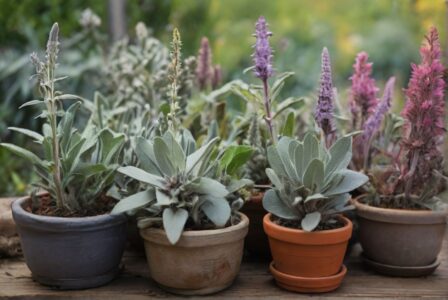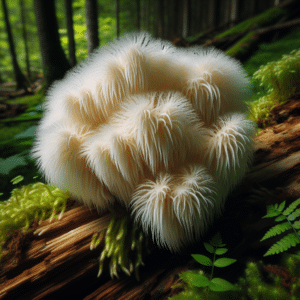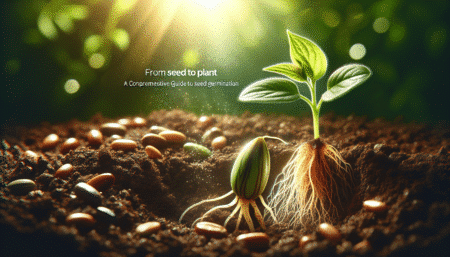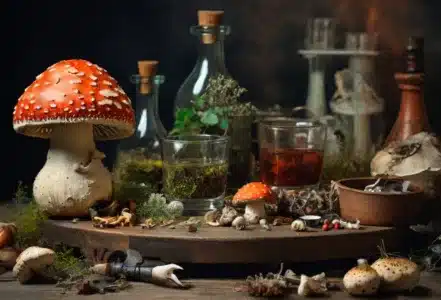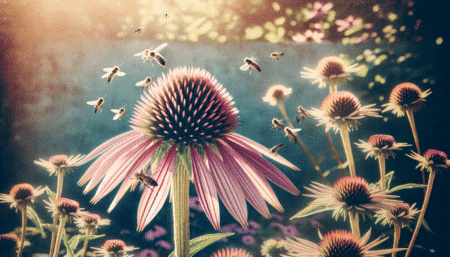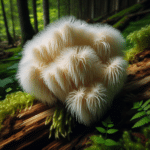- Introduction
- History of shamanism and medicinal cacti
- Trichocereus pachanoi - The San Pedro cactus
- Trichocereus peruvianus - The Peruvian Cactus
- Rituals and application methods
- Dangers, risks and legal situation
- Conclusion and modern relevance
Here you can find our Trichocereus and Echinopsis seeds!
1. introduction
The San Pedro cactus (Trichocereus pachanoi), known for its psychoactive properties due to the presence of mescaline, is a species of cactus native to the Andes and has been used for divination and healing by shamans and spiritual seekers for over 3500 years [1][2]. Its use offers unique spiritual experiences that lead to a better understanding of the multidimensional nature of existence and the merging of other dimensions with physical reality. San Pedro differs from Ayahuasca through its gentler, masculine energy, which helps to heal inner wounds and build a stronger connection with the world around us [2].
In this article, we take an in-depth look at the San Pedro cactus, also known as Huachuma, and explore its importance in the Shamanismits applications and Cultural and spiritual practices. We also shed light on the legal aspects and risks associated with the use of such psychedelic substances. By looking at Trichocereus pachanoi and Trichocereus peruvianus, we learn more about the diverse medicinal plants, entheogens and their role in shamanistic rituals [2].
2. history of shamanism and medicinal cacti
- Origin of shamanism
- The term "shaman" comes from the Tungusic languages and means "someone who knows" [3]. Shamans are considered spiritual specialists who can reach a state of ecstasy at will, claiming that their soul leaves the body and travels to the spirit world [3].
- Techniques and practices
- Medicinal cacti in shamanistic rituals
- Medicinal cacti, such as the peyote cactus, which contains the psychoactive substance mescaline, are used by some indigenous tribes in North America for spiritual and healing purposes [3]. The San Pedro cactus, which is used in traditional Andean medicine, is another example of a psychoactive medicinal cactus [3]. The use of these plants is often surrounded by rituals and ceremonies and is considered a sacred practice in many cultures [3].
3. trichocereus pachanoi - the San Pedro cactus
The San Pedro cactus, also known as Echinopsis pachanoi, is a fascinating plant native to the Andes and has a rich history in shamanistic rituals and healing practices. Its psychoactive properties, mainly due to the presence of mescaline, make it a powerful tool for spiritual exploration and healing. Therapeutic applications. Here are some important aspects of this unique cactus:
- Psychoactive components and effects:
- Contains mescaline, a psychoactive alkaloid known for intense hallucinations, vivid dream-like imagery and feelings of intense happiness and deep inner connection with the world [5] [10].
- The effects of San Pedro and mescaline can include visual hallucinations, altered perception of time and profound emotional experiences, with the onset of effects lasting 30-50 minutes and the peak event occurring after about 3 hours. The entire experience can last up to 18 hours [5].
- It is recommended to start with a low dose and gradually increase it if necessary, as the amount of mescaline in the San Pedro cactus can vary greatly [5].
- Cultivation and ecological importance:
- The cactus is native to Ecuador, Peru and Colombia and grows at altitudes of 2,000-3,000 meters. It normally reaches a height of 3-6 m and has a trunk with a diameter of 6-15 cm, which is light to dark green and has 6-8 ribs [7] [9].
- San Pedro can be described as Ornamental plant and contributes to landscaping by creating green oases. It has various ecological implications, including sustainable cultivation methods, habitat for fauna and interaction with insects, birds and wildlife [11].
- Cultivating the San Pedro cactus presents challenges in maintaining its unique shapes. Pruning and trimming may be necessary to maintain the desired aesthetics. It is capable of growing in USDA hardiness zones 8b to 10 and requires fertile, well-draining soil [12] [13].
- Legal situation and safety instructions:
- Although it is legal to cultivate the San Pedro cactus in most countries, cultivation for consumption is prohibited in countries where possession of mescaline and related compounds is illegal [13].
- There are no reported deaths from mescaline use, but it can lead to negative psychological experiences, especially in people with a history of mental health problems. Combining mescaline with other substances, especially MAOIs, can be dangerous [5].
4. trichocereus peruvianus - the Peruvian cactus
Trichocereus peruvianus, also known as the Peruvian torch cactus or blue torch cactus, is a fascinating member of the cactus genus Trichocereus and is prized for its psychoactive properties. Here are some important facts about this particular cactus:
- Growth and care:
- LocationNative to the western Andean slopes of central and southern Peru, Trichocereus peruvianus thrives at altitudes between 2,000 and 3,350 meters [16].
- CultivationThis cactus is easy to grow and can withstand harsher conditions. It can grow in almost any material as long as at least 50% of it provides drainage [15].
- CareTrichocereus peruvianus should have its stem topped between the sixth and tenth month to encourage thicker and stronger growth. In the second year it can be repotted into six or eight inch pots and will need repotting almost every year for optimum growth [15].
- Features:
- AppearanceTrichocereus peruvianus can reach a height of over 5.8 meters and is characterized by its glaucous blue-green, chunky stems with a diameter of up to 15 cm. It is armed with strong thorns that can be longer than 3.8 cm [16].
- Blossoms: The white, fragrant, night-blooming flowers can reach a diameter of up to 25 cm [16] [19].
- Use and dosage:
- ConsumptionPreparation: the outer layer is peeled against the skin and dried, then either ground into a fine powder or boiled into a tea [15].
- DosageOne dose consists of 350 to 500 mg, which should be taken in two doses about half an hour apart [15].
- Harvest: When harvesting, it is best to cut a 10 to 25 cm long piece from the top for replanting and then make another cut about 25 cm long for consumption. The bottom and last cut should be made at a 10 to 20 degree angle to allow for water drainage while the cut heals [15].
Trichocereus peruvianus is not only a plant of great spiritual significance, but also a popular cactus among plant lovers because of its robust nature and impressive appearance.

5. rituals and application methods
The San Pedro cactus offers a variety of preparation and application options that can be used for both ritual and personal purposes. Here are some ways you can prepare and use the cactus for your spiritual or healing practices:
- Preparation for consumption:
- HarvestSelect a healthy part of the cactus and cut it off carefully. It is important that the cactus is in good condition to achieve the best results [20].
- Peeling: Remove the outer skin of the cactus to access the green flesh containing the psychoactive substances [20].
- CookingThe green flesh can be cooked to create a potion that can then be consumed. This method is one of the traditional ways of using the cactus [20].
- Application methods for personal growth and healing:
- MeditationSan Pedro cactus is often used in meditative practices to find inner peace and strengthen the connection to the self [11].
- Artistic inspirationMany use the cactus as a source of inspiration in art to overcome creative blocks and gain new perspectives [11].
- Personal growth: The use of San Pedro can lead to positive, long-term changes in life by contributing to self-discovery and healing [21].
- Growth and care of the cactus:
- Growing from seedSan Pedro can be grown from seed, which allows for a deeper connection to the plant as you are with it from the start [20].
- Purchase as a whole plant: For those who do not wish to go through the process of cultivation, the cactus can also be purchased and cared for as a whole plant [20].
These methods and applications of the San Pedro Cactus open up a wide range of possibilities for those seeking spiritual growth, healing or simply a way to enhance their creative energy. With the right preparation and attitude, the San Pedro Cactus can be a powerful tool on your path to self-discovery [20][11][21].
6. hazards, risks and legal situation
- Legal status of mescaline and San Pedro cactus:
- In Germany and many other countries, mescaline is illegal, but possession of cacti containing mescaline is generally permitted [10].
- In Mexico, the use of mescaline in religious ceremonies is legal [10].
- Possession of the live plant is legal in Germany, but the preparation and sale of dried parts is illegal, as they fall under the manufacture of narcotics [22].
- In Switzerland, the San Pedro cactus is classified as a narcotic and its possession is illegal [22].
- The San Pedro cactus is legal for garden use and as decoration in Germany and the Netherlands [23].
- Risks and safety instructions:
- Cultivation and possession of the San Pedro cactus:
- The cultivation and possession of the San Pedro cactus is legal in Germany, but extracting mescaline from the cactus is illegal and punishable by law [20].
- San Pedro cactus can be legally purchased and grown as an ornamental plant in Germany and the Netherlands [23].
- Due to the psychoactive properties of the plant, legal issues can arise and it is crucial to understand and comply with local laws and regulations [12].
7 Conclusion and modern relevance
Through the in-depth study of the San Pedro cactus and Trichocereus peruvianus, we have gained a deep understanding of their importance in shamanistic rituals and their role in the spiritual exploration obtained. The fascinating psychoactive properties of these medicinal cacti offer unique opportunities for both personal transformation and cultural practice to expand human existence and consciousness. Their uses range from fostering creative inspiration to assisting in the healing of inner wounds, highlighting their profound effect on human consciousness.
At the same time, the study of the legal framework and potential risks underlines the importance of responsible use of these powerful plants. It is crucial to observe the legal regulations and raise awareness of the psychological and physical effects in order to avoid negative experiences. The traditional use of the San Pedro cactus and Trichocereus peruvianus thus not only summarizes their spiritual and healing role, but also emphasizes the need for a conscious and respectful approach to their powers.
Further questions and answers about the San Pedro cactus
What are the dangers of mescaline?
Taking mescaline can lead to a drug-induced psychosis. This often manifests itself in the form of pseudo-hallucinations, which can be perceived by the user as very frightening, known as "horror trips".
How do you get a cactus to develop flowers?
To encourage a cactus to flower, it should be kept cool and dry during the winter dormancy period. After this dormant phase, which lasts until around March, the plant can be returned to a sunny location, for example in a south-facing window, and watered more frequently. This promotes the formation of buds.
YouTube
Note: The information in this article is for informational purposes only and is not intended to replace the advice of a physician or other healthcare professional. Always consult a doctor before using any new herbs or supplements. Furthermore, you should always check whether the cultivation/possession/use/processing of certain plants is permitted in your country. As we only offer ornamental plants in our store, we are only allowed to offer Provide information and advice on the correct care of plants!
References
[1] – https://www.zamnesia.com/de/content/218-was-ist-ein-san-pedro-kaktus
[2] – https://om-mij.nl/de/san-pedro/
[3] – https://de.wikipedia.org/wiki/Schamane
[4] – https://de.wikipedia.org/wiki/Schamanismus
[5] – https://www.setandsetting.de/san-pedro/
[6] – https://acsauhaya.org/de/san-pedro-kaktus/
[7] – https://en.wikipedia.org/wiki/Trichocereus_macrogonus_var._pachanoi
[8] – https://www.gdncnursery.com/store/san-pedro
[9] – https://www.quora.com/What-is-the-San-Pedro-cactus-used-for
[10] – https://www.spektrum.de/wissen/meskalin-mystik-aus-kaktusspitzen/1604544
[11] – https://ovidius.blob.core.windows.net/meskalin-kakteen/san-pedro-kaktus/san-pedro-kaktus-und-ayahuasca.html
[12] – https://drgrowkit.com/de/san-pedro-cutting-monstrosus-a-unique-cactus-in-focus/
[13] – https://www.gardenia.net/plant/trichocereus-pachanoi
[14] – https://www.sanpedrosource.com/
[15] – https://www.magicactus.com/trichocereus.html
[16] – https://lonestarnursery.com/products/cactus-peruvian-torch
[17] – https://thesucculentsource.com/products/ec20-cactus-trichocereus-bridgesii-ornamental-cacti-san-pedro-pachanoi-peruvian-cereus
[18] – https://cactusculture.com.au/shop/p/trichocereus-peruvianus-seeds
[19] – https://trichocereus.net/trichocereus-peruvianus-echinopsis-peruviana/
[20] – https://cbd-deal24.de/meskalin-kakteen/san-pedro-kaktus/
[21] – https://spiritrivers.com/de/medizin-der-vorfahren/was-ist-ein-huachuma-oder-san-pedro-kaktus-erfahrungen-vorteile-und-nebenwirkungen/
[22] – https://www.chemie.de/lexikon/Echinopsis_pachanoi.html
[23] – https://www.wholecelium.com/de/blog/was-ist-san-pedro-kaktus/


